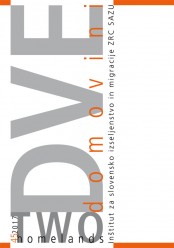Določanje najboljših koristi mladoletnih migrantov brez spremstva v Sloveniji
DOI:
https://doi.org/10.3986/dd.2017.1.06Ključne besede:
mladoletni migranti brez spremstva, otrokova najboljša korist, migracije, otrociPovzetek
Članek se ukvarja z mladoletniki brez spremstva, to je z mladoletniki, ki so v pravni terminologiji opredeljeni kot mladoletni državljani tretjih držav in so na območju Slovenije sami, brez staršev ali zakonitega zastopnika. V Sloveniji imajo mladoletni migranti brez spremstva različne statuse, med katerimi vsak vsebuje različne zakonske določbe ter praktične določitve otrokovih najboljših koristi, ki naj bi bile usklajene s Konvencijo OZN o otrokovih pravicah. Članek ponuja tudi pregled vključevanja načela otrokovih najboljših koristi v nacionalno zakonodajo in druge formalne predpise, ki določajo postopke in obravnave omenjenih skupin otrok. Obenem obravnava način sprejemanja zakonskih ukrepov, njihovega izvajanja ali nadzorovanja ter kako strokovnjaki v različnih formalnih postopkih razumejo in določajo načelo najboljše koristi otroka.
Prenosi
Literatura
Act Amending the International Protection Act (ZMZ-D) (2013). Official Gazette of the RS 111/13.
Aliens Act (ZTuj-2) (2011). Official Gazette of the RS 50/11.
Aspinall, Peter, Watters, Charles (2010). Refugees and Asylum Seekers: A Review from an Equality and Human Rights Perspective. Equality and Human Rights Commission, http://www.equalityhumanrights.com/sites/default/files/documents/research/refugees_and_asylum_seekers_research_report.pdf (9. 5. 2016).
Bloomfield, Alice, Tsourdi, Evangelia, Pétin, Joanna, de Bruycker, Phillipe (eds.) (2015). ‘Alternatives to Immigration and Asylum Detention in the EU: Time for Implementation’, https://fluechtlingsdienst.diakonie.at/sites/default/files/fluechtlingsdienst/files/madereal-report-_alternatives_to_detention_in_the_eu.pdf (19. 10. 2016).
Boylan, Michael (2012). Dolžnosti do otrok. Časopis za kritiko znanosti, domišljijo in novo antropologijo 40/249, 53–66.
Cemlyn, Sarah Judith, Nye, Miriam (2012). Asylum seeker young people: Social work value conflicts in negotiating age assessment in the UK. International Social Work 55, 675–688.
Civil Procedure Act (ZPP) (1999). Official Gazette of the RS 73/07.
Committee on the Rights of the Child (2005). General Comment No. 6 on “Treatment of unaccompanied and separated children outside their country of origin”, http://www2.ohchr.org/english/bodies/crc/docs/GC6.pdf (2. 8. 2015).
Council Directive 2003/86/EC of 22 September 2003 on the right to family reunification.
Directive 2008/115/EC of the European Parliament and of the Council of 16 December 2008 on common standards and procedures in Member States for returning illegally staying third-country nationals. Official Journal of the European Union L 348/98.
Directive 2013/32/EU of the European Parliament and of the Council of 26 June 2013 on common procedures for granting and withdrawing international protection. Official Journal of the European Union, L 180/60.
Directive 2013/33/EU of the European Parliament and of the Council of 26 June 2013 laying down standards for the reception of applicants for international protection. Official Journal of the European Union, L 180/96.
European Commission (2010). Action Plan on Unaccompanied Minors (2010–2014) (COM(2010) 213 final), http://eur-lex.europa.eu/LexUriServ/LexUriServ.do?uri=COM:2010:0213:FIN:en:PDF (2. 8. 2015).
Gros, Hanna, Song, Yolanda (2016). “No Life for a Child”: A Roadmap to End Immigration Detention of Children and Family Separation. Toronto: International Human Rights Program, University of Toronto Faculty of Law.
Hodgkin, Rachel, Newell, Peter (2007). Implementation Handbook for the Convention on the Rights of the Child. Fully revised third edition. Geneva: UNICEF, http://www.unicef.org/publications/files/Implementation_Handbook_for_the_Convention_on_the_Rights_of_the_Child_Part_1_of_3.pdf (2. 8. 2015).
International Protection Act (ZMZ-UPB2), Official Gazette of RS 11/2011.
International Protection Act (ZMZ-UPB2) (2011). Official Gazette of the RS 11/2011.
International protection Act (ZMZ-1) (2016). Official Gazette of the RS 22/2016.
Jones, Adele (2001). Child Asylum Seekers and Refugees. Rights and Responsibilities. Journal of Social Work 1, 253–271.
Kallio Kirsi, Pauliina (2012): Desubjugating Childhoods by Listening to the Child’s Voice and Childhoods at Play. An International E-Journal for Critical Geographies 11/1, 81–109.
Lundberg, Anna (2011). The Best Interests of the Child Principle in Swedish Asylum Cases: The Marginalization of Children’s Rights. Journal of Human Rights Practice 3/1, 49–70.
Marriage and Family Relations Act (ZZZDR-UPB1) (2004, 2007). Official Gazette of the RS 69/04, 101/07.
Ministry of the Interior (2015). Poročilo z delovnega področja migracij, mednarodne zaščite in vključevanja za leto 2014. Ljubljana: Ministrstvo za notranje zadeve.
Regulation (EU) No 604/2013 of the European Parliament and of the Council of 26 June 2013 establishing the criteria and mechanisms for determining the Member State responsible for examining an application for international protection lodged in one of the Member States by a third-country national or a stateless person. Official Journal of the European Union, L 180/31.
Sedmak, Mateja, Lenarčič, Blaž, Medarić, Zorana, Žakelj, Tjaša (2017). »Not our children«: Unaccompanied Minor Asylum Seekers in Slovenia. London: Routledge, forthcoming.
Slovene Philanthropy and Legal-Informational Centre for Non-Governmental Organizations – PIC (2009). Policies on reception, return, integration arrangements for, and numbers of, unaccompanied minors in the Republic of Slovenia.
Slovene Philanthropy (2013). Implementing the core standards for guardians of separated children in Europe, Country assessment: Slovenia.
UNHCR (1989). Convention on the Rights of the Child, http://www.un.org/ga/search/view_doc.asp?symbol=A/RES/44/25 (30. 5. 2015).
UNHCR (2008). Guidelines on Determining the Best Interests of the Child. Geneva, http://www.unhcr.org/protect/PROTECTION/4566b16b2.pdf (2. 8. 2015).
UNHCR (2011). Field Handbook for the Implementation of UNHCR BID Guidelines, http://www.unhcr.org/50f6d27f9.html (23. 7. 2016).
UNHCR (2014). Safe and Sound: What States can do to ensure respect for the best interests of unaccompanied and separated children in Europe, http://www.refworld.org/docid/5423da264.html (13. 8. 2016).
Žakelj, Tjaša, Lenarčič, Blaž, Medarić, Zorana, Sedmak, Mateja (eds.) (2015). Implementation of unaccompanied minors' rights in Slovenia: An analysis based on the best interest of the child principle. A journey to the unknown: The rights of unaccompanied migrant children: Between theory and practice. Koper: Annales University Press, 42–99.
Prenosi
Objavljeno
Kako citirati
Številka
Rubrike
Licenca

To delo je licencirano pod Creative Commons Priznanje avtorstva-Nekomercialno-Brez predelav 4.0 mednarodno licenco.
Avtorji jamčijo, da je delo njihova avtorska stvaritev, da v njem niso kršene avtorske pravice tretjih oseb ali kake druge pravice. V primeru zahtevkov tretjih oseb se avtorji zavezujejo, da bodo varovali interese založnika ter da bodo povrnili morebitno škodo.
Podrobneje v rubriki: Prispevki





